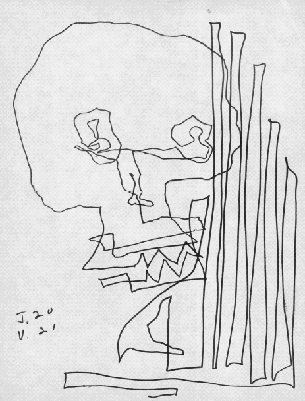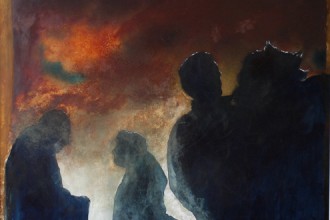This text is part of an essay by Marcelo Villena Alvarado that originally appeared in Escrituras Americanas, published by the philosophy department of the Universidad Metropolitana de Ciencias de la Educación in Chile.
What should one do when the time comes to look at the pen strokes of the drawings of Jaime Saenz, the circular strokes and dizzy loops? How can one understand them as a series of shifts from skulls to self-portraits?
1) One must look at the “Skull of man†amidst divinations and epiphanies, and see the circular strokes and dizzy loops in the spiral formed by cranium, eyes, cheeks and other features.
2) One must touch and follow these unique markings on a sheet of paper, screen or wall, follow them with the eye while also following chance and circumstance, serendipity, tastes, days of the year, rains, tremors and earthquakes.
3) One must touch the “Skull of a lady†and see how the body is inscribed there (not just thought, as Heidegger would have liked), pen in hand in the fissure, in the trace of eyes and nose.
4) One must speak with a young lady worried about her lack of grandeur.
5) One must look again at the drop that once fell on a sheet and left a trace, look at it remembering drawing is a combination of lines and smudges; one must see that on the skulls the spiral becomes a smudge, or descends precisely there where the drawing gives off a scent.
6) Between the “Skull of a globeâ€, the “Skull in loveâ€, and the skull with a flourish one must recognize the signature of Jaime Saenz; one must appreciate the circular stroke in his initials (the J, the S), that in the drawing become a single thing, the same line opening in a spiral. And one must verify that there the circular stroke unfolds, moves away, and descends three times.
7) One must do many things, and at the same time do nothing: look at the drawings for hours, lose track of time, take a turn starting at the corner of Santa Cruz and Jiménez streets, descending Santa Cruz to Lanza street, veering left on Evaristo Valle, climbing toward Churubamba, resting on América avenue on the way to the convent of Recoleta.
8) One must look at the self-portraits of Jaime Saenz and see that on 28 November 1962, he went from drawing “out of idiocyâ€Â as a “stupid way of passing timeâ€Â to drawing “in preparation for writingâ€. In the image of the self-portrait the circular stroke and dizzy loop plunge toward the smudge, the blot, writing.
9) One must look at the profile once silhouetted on the blank surface of the wall, now flooded in deeper and deeper darkness, and remember Pliny and the myth of the origin of painting, drawing, writing: the myth that tells us how form emerged while cut off from its material of origin, the well-known anecdote of the young person who “outlined the shadow of the face of a loverâ€.
Marcelo Villena Alvarado wrote his doctoral thesis on Roland Barthes under the supervision of Julia Kristeva. He is the author of ‘las tentaciones de san ricardo’, seven essays on Bolivian narrative.





